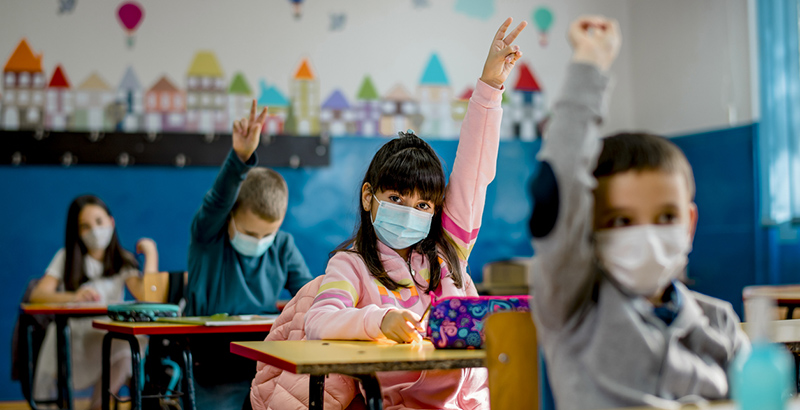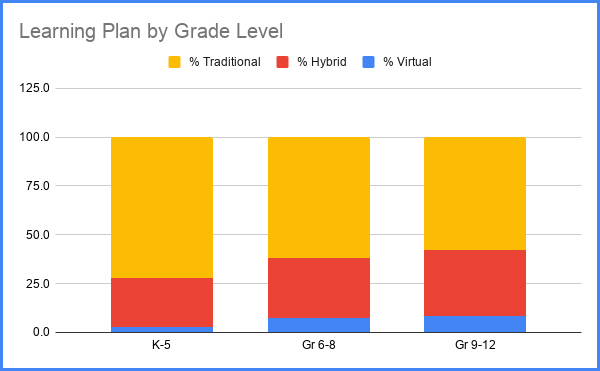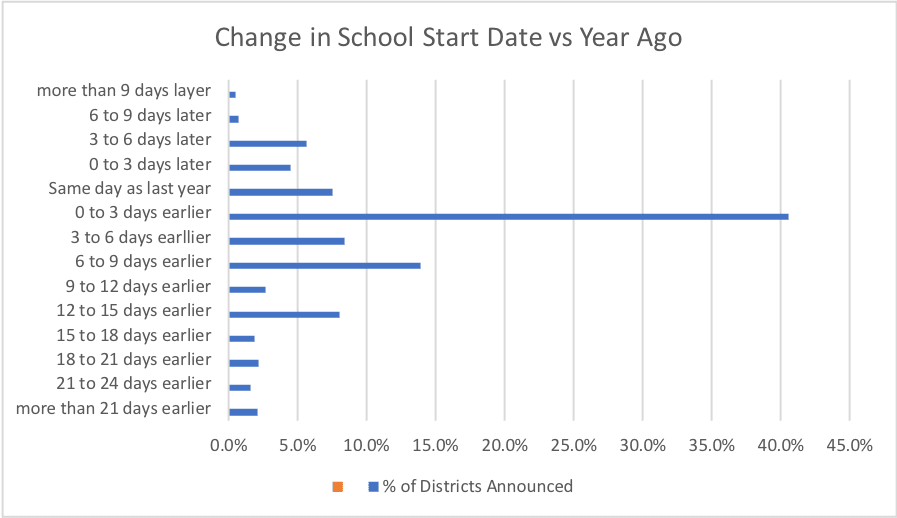This Week In School Reopenings: As Biden’s 100-Day Mark Approaches, 97% of Youngsters Have Access To In-Person Classes

With the end of the pandemic seemingly in sight, more and more schools are transitioning toward full-time in-person learning. Now, only 1 in 20 students nationwide are attending remote-only schools.
That’s a pretty good look for President Joe Biden, who has pushed for the majority of schools to reopen by his first 100 days in office. That benchmark comes Friday, April 30, and according to a recent update, nearly two-thirds of students are attending schools that offer daily in-person instruction.
Still, even where schools have opened their doors to students, that doesn’t mean all families have chosen to return their kids. As The 74’s Linda Jacobson reports, critics of the president wonder whether he could be doing more for the students who have opted to continue with remote learning. “There are still a lot of kids sitting at home right now,” they note.
But though students nationwide continue to attend virtual school, the future of online learning appears to be in question. Some school systems plan to continue with remote instruction for the balance of this school year, ditching reopening entirely. At the same time, others plan to drop online school entirely next fall, as parent interest seems to have waned.
Here’s what you need to know about the state of play on school reopenings across the nation, powered by data from the school calendar tracking website Burbio.
1 97% of youngster have access to in-person learning
While rates of virtual schooling dropped across all grade levels last week, the share of elementary schoolers still fully online has reached a notable low — approaching zero. Seventy-two percent of youngsters go to schools with daily in-person instruction, and another 25 percent attend schools with hybrid models. Put together, a full 97 percent of K-5 students have access to some in-person learning.
Rates of virtual learning also fell for middle and high schoolers, though the overall share remains slightly higher. Eight percent of 6-12 graders attend schools that operate fully remote. Sixty-two percent of middle school students and 58 percent of high school students attend schools offering full-time in-person learning.
Across all grade levels, 65 percent of students attend schools that offer daily, in-person learning, 29 percent of students go to schools using a hybrid model and only 6 percent attend schools that remain fully online.

2 A teacher in the White House
As schools have pushed to open their doors, the First Lady has become something of an ambassador to in-person learning, visiting reopened classrooms across the country.
“Teachers want to be back. We want to be back. Last week I said to my students, ‘Hey guys, how you doing?’” the First Lady, who has maintained her job teaching at Northern Virginia Community College, told students during a visit at Benjamin Franklin Elementary School in Meriden, Connecticut, in March. “And they said, ‘Dr. B, we’re doing OK, but we can’t wait to be back to the classroom•.’ •And I think that’s how we all feel. But we just know that we have to get back safely.”
Here are some of the highlights, captured in 15 images, of Dr. Biden’s nationwide school tour.
3 The districts that never reopened
While the vast majority of school systems have returned students to classrooms in some way, shape or form, there have been some holdouts.
In California, San Bernardino, Fremont and Santa Ana Unified have all announced plans to stay virtual through the remainder of this spring. Michigan districts such as Kalamazoo, Lansing and Detroit have decided the same. In Richmond, Virginia, students with special needs have the option to attend school in person, but classrooms remain closed to the general population.
4 States and districts plan 2021-22 virtual offerings
Though COVID-19 vaccinations have progressed at a swift rate in the United States, the pandemic rages on abroad, with record daily case totals in India. That means that there are no guarantees about a return to normalcy next fall, and many school systems are preparing to maintain virtual offerings for families who prefer to keep their kids at home.
Richmond, Virginia, Central Dauphin, Pennsylvania and Las Vegas, Nevada will each have virtual academies next year that families can opt into. The Las Vegas model will require a sign-off from students’ principals and an adult at home for elementary students.
Other districts — including Douglas County, Georgia; West Claremont, California; Frisco, Texas and Scranton, Pennsylviania — are opening virtual learning for next fall, but not to their youngest students. Age cutoffs range from third to sixth grade.
In response to widespread demand for remote offerings, some states are rolling out statewide virtual academies for the 2021-22 school year. Iowa, Missouri and Virginia have each launched such schemes.
But in many locales, such as Washington, D.C., internet for remote learning remains a key concern.
5 Other districts abandon remote school next year
At the same time as some districts are planning out their remote academies for the fall, other school systems have decided to forgo virtual learning altogether for the 2021-22 school year.
Chapel Hill-Carrboro, North Carolina, South Washington, Minnesota and Mason City, Ohio each announced that they do not plan to offer online instruction next year, citing state regulations and low interest.
In Gwinnett County, Georgia’s largest school district, only 2 percent of students have opted into virtual learning options for next fall. And in New Jersey, Gov. Phil Murphy stipulated during a coronavirus update in late March that districts in the state will not be allowed to offer remote learning, even for parents who prefer that option.
6 An early start to next school year
According to school calendars, many districts are planning to bump up the start of next school year by anywhere from a handful of days to multiple weeks. More than 40 percent of districts are shifting their start date by over five days due to the COVID-19 disruptions of the prior year.

7 Do 4-day weeks amount to ‘hygiene theater?’
Amid fears of COVID-19 safety, many school districts have adopted four-days-a-week schedules that pause live instruction for a full day to allow for disinfecting of school buildings, researchers at the Center for Reinventing Public Education have found.
But with recent clarification from the CDC that ventilation and masking — not wiping down surfaces — are the most effective ways to mitigate virus spread in schools, The 74 contributors Robin Lake and Georgia Heyward make the case that schools should avoid such schedules.
Closing school one day a week for cleaning is nothing more than “hygiene theater,” they argue — and robs students of valuable learning time.
Many districts were exploring four-day schedules even before the pandemic, amid fierce debates over the pros and cons. An update from early last year shows that 560 districts in 25 states had at least one school on a four-day schedule. According to Lake and Heyward’s current sample, which finds that over a quarter of in-person schools and nearly two-thirds of hybrid schools now close one day a week for cleaning, COVID-19 seems to only have accelerated uptake of the abbreviated school week.
Get stories like these delivered straight to your inbox. Sign up for The 74 Newsletter

;)
